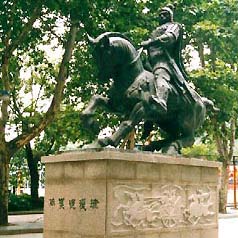|
Hefei, capital of Anhui, lies in the heart of the province between the Yangtze River and the Huaihe River. The city is on the Bengbu-Yuxikou Railway and is joined with the Yangtze by waterway via Lake Chaohu.
Hefei became a commercial center over two thousand years ago. Its position of strategic importance made it a battlefield in many historical conflicts. It is now the political, economic, and cultural center of Anhui Province with newly developed industries including iron and steel, machine building, electronics, construction materials, textiles, dyes, and chemicals.
Leisure Ford Park (Xiaoyaojin Park)

The contradictorily named Leisure Ford Park (Xiaoyaojin Park) is well known in modern China as a famous battlefield. Although history faithful to the truth is a little hard to track down, most accounts in China now go like this.
In the last years of the Eastern Han Dynasty (25-220 AD), a general called Sun Quan, afterwards to become king of the Wu Kingdom, led a troop of 100,000 soldiers towards Hefei, with plans to take the city. The city general, a subordinate of the famous Cao Cao, named Zhang Liao, had but 7,000 troops under his command. Troops were fearful and restless awaiting the onslaught that was sure to result in the sacking of the city. So Zhang thought he would try to even up the odds.
Taking almost all of his troops, Zhang initiated a night blitz upon the unprepared Sun barracks and the bloody battle that ensued was to eventually result in the rout of Sun's unprepared army. Sun is said to have escaped death by leaping the canal that ran beside the battlefield.
Nowadays the area has lost much of its charm. It was turned into a park this century, and now covers a total of 31.3 hectares. The park is an uninspiring thing that is probably only of interest to Chinese history lovers, botanists and sadistic zoologists. The zoo in the southeastern corner of the park is typical of China's zoos, with small cages and poor facilities. The western corner has bonsai, rare Chinese plants, rockeries as well as mock versions of traditional Chinese architecture. There are also three islets on the lake, that between them hold a cenotaph of general Zhang Liao, a statue of him seated upon his horse and a bridge that is said to be the spot that Sun Quan leapt to freedom.
Address: No.16, Shouchun Road, Hefei;
Opening hours: 06:00-18:00;
Entry ticket: 5 yuan;
Traffic: Bus No.s 2, 129, 136,137 and 801;
Tel: 0551-2654575.
Terrace for Training Archers (Jiaonutai)
This terrace is inside the east gate of Hefei. It is five meters high and covers 3,700 square meters.
According to the city's records, Cao Cao had the terrace erected for training archers the use of the crossbow to resist Sun Quan's navy.
A well on the terrace is called High Well (Gaojing) or roof tops of the bungalows in the streets below. Grooves in the rock, made by the ropes used for hauling up water, are still visible on the rim.
Mingjiao Temple on the terrace contains an iron Buddha six meters high and weighing over five tons.
Address: East Section of the Huaihe Road, Hefei;
Opening hours: 07:30 -- 18:00;
Entry ticket: 10 yuan;
Transport: Bus No.s 1, 3, 9, 101,103 and 106;
Tel: 0551-2656284.
Temple of Magistrate Bao
This temple was built on Xianghua Mound in Baohe Park in memory of Bao Zheng (999-1062) of the Northern Song Dynasty.
Born in Hefei, Bao Zheng was an honest official known as "Upright Magistrate Bao," who had once and his portrait carved on a stone, as well as relics unearthed from his tomb.
A well beside the temple is called "Upright Spring (Lianquan)," and it is said that corrupt officials of the town dared not drink the springwater.
The willow-lined Xianghua Mound is surrounded by water, in which water chestnuts and lotus flowers grow lavishly, and is connected to land by a bridge. Lotus roots flourish in the nearby Baohe River.
Address: No.72, Wuhu Road, Hefei;
Opening hours: 07:30-17:30;
Entry ticket: 20 yuan;
Traffic: Bus No.s 6, 11, 28, 47 and 110;
Tel: 0551-2884124.
(China.org.cn)
|

